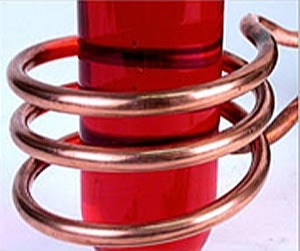About Nanoparticle Induction Heating
Induction heating is a convenient and flexible method to deliver high-strength magnetic fields to nanoparticles, resulting in a focused and targeted treatment that is gaining considerable interest in the medical research community. Induction heating systems are used in thermotherapy to generate alternating magnetic fields in the laboratory to elevate and manage the temperature of a solution of nano-particles in vitro or (in animal studies) in vivo.
- Home
- Industries
- Nanoparticle Heating

Our systems for nanoparticle heating research accommodate your research power and frequency needs, providing accurately adjustable power-levels from 1 kW to 10 kW and configurable frequency ranges from 150kHz to 400kHz. Core field-strengths up to 125 kA/m can be achieved.
These papers and references showcase some of the more interesting and breakthrough work being done with induction heating in hyperthermia-assisted research.
♦ Nanoparticle Heating (2014 Girish Dahake PhD., Ambrell, an Ameritherm Co.)
♦ Effective Elimination of Cancer Stem Cells by Magnetic Hyperthermia (2013 Sadhukha, Niu, Wiedmann and Panyam; Molecular Pharmaceutics)
♦ Inhalable magnetic nanoparticles for targeted hyperthermia in lung cancer therapy (2013 Sadhukha, Wiedmann and Panyam; Biomaterials)
♦ Feasibility of Magnetic Particle Films for Curie Temperature-Controlled Processing of Composite Materials (2001 Wetzel, Fink; Army Research Laboratory)
♦ Adherend Thermal Effects During Bonding With Inductively Heated Films (2001 Wetzel, Fink; Army Research Laboratory)
♦ Induction cure of adhesives for composite repair applications (James M. Sands; Army Research Laboratory, Aberdeen Proving Ground, MD)
♦ Induction curing of a phase toughened adhesive (2003 Christian J. Yungwirth, et. al.; Army Research Laboratory, Aberdeen Proving Ground, MD)
♦ Remotely triggered release from magnetic nanoparticles
♦ Local heating of discrete droplets using magnetic porous silicon based photonic crystals (2006 Ji-Ho Park et. al.; Department of Chemistry and Biochemistry, University of California, San Diego)
♦ Rapid synthesis of carbon nanotubes via inductive heating (2006 Sosnowchika and Lin; University of California at Berkeley)
♦ Intratumoral iron oxide nanoparticle hyperthermia (2007 Hoopes, P.J., et. al., Dartmouth)
♦ Synthesis and characterization of ZnO nanoparticles having prism shape by novel gas condensation process (2008 Chang,Tsai;Department of Mechanical Engineering, National Taipei University of Technology)
♦ Inductively heated shape memory polymer for the magnetic actuation of medical devices (2006 Patrick R. Buckley et. al,; Lawrence Livermore National Laboratory (LLNL), Livermore, CA)
♦ Heating solutions in vials for cancer research
♦ Heating magnetic iron oxide in water for hyperthermia application
♦ Heating nano particles for cancer research
♦ Producing a gallium arsenide wafer
♦ Biofunctionalized magnetic-vortex microdiscs for targeted cancer-cell destruction Dong-Hyun Kim et. al.
AMBRELL CORPORATION
1655 Lyell Avenue
Rochester, NY 14606
United States
F: +1 585 889 4030
AMBRELL B.V.
Holtersweg 1
7556 BS Hengelo
The Netherlands
AMBRELL Ltd.
Unit 6, Space Business Centre
Tewkesbury Road
Cheltenham, GLOS, GL51 9FL
United Kingdom
F: +31 546 788 154

